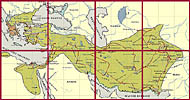Alexander the Great, after succeeding his father Philip II to the Macedonian throne and suppressing the disturbances in the interior of Macedonia, succeeded in only a few years (sometimes through military operations and sometimes through diplomacy) in conquering the cities of central Greece. A Panhellenic expedition into Asia was his intention, although it is not absolutely certain whether he had truly apprehended a completed plan to conquer a vast empire.
Gradually, he abolished the Persian state, occupying each country until the African deserts in the south and the Jaxartes and Indus rivers in the east.
The first decisive victory on Granicus river facilitated Alexander's access into the interior of Asia, and at the same time liberated the Greek cities at the Ionian coasts from the Persian suzerainty. For this victory he dedicated to the goddess Athena, 300 suits of armour from the booty, with the following inscription: "Alexander, son of Philip II, and the Greeks, except the Lacedaemonians, from the booties of the barbarians who inhabit Asia". He clearly intended, as he underlined by the omission of any special reference to the Macedonians, to emphasize the Panhellenic nature of his expedition.
In Egypt the priests saluted him as the son of the god Amon Ra, an action that declared Alexander's recognition as a pharaoh. According to some scholars, in
| introduction | Alexander | successors | kingdoms | Greece | freedom |
Note: Click on the small photo to enlarge it.

01. Map indicating the course of Alexander's expedition into central Asia and the positions of the most important

02. Gold double stater of Alexander III of Macedon,